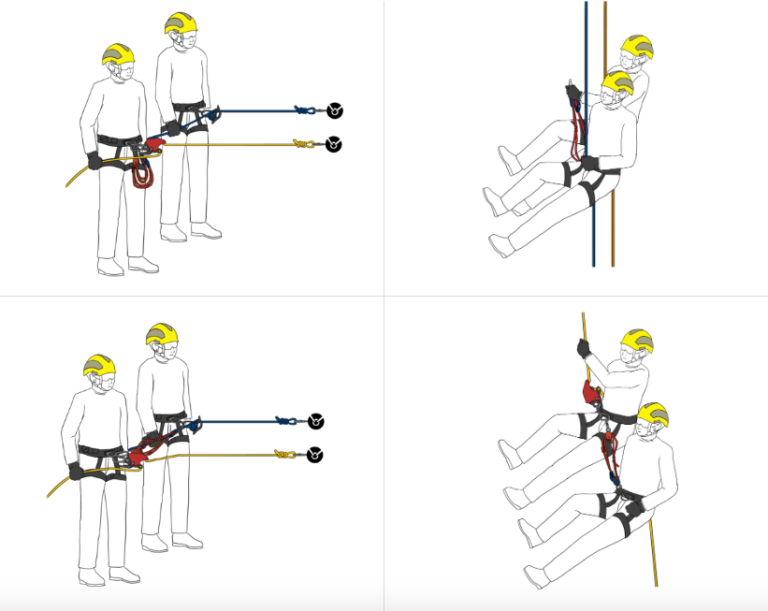In the following illustrated examples, we are using the Harken CMC Clutch and AZTEK (MA “set of fours”) to effect the rescue pickoff.
Since a rappel pick off is a rescue, an independent belay should be used. In these illustrations, we have left off showing the belay line for clarity. If the team has a second rope or can double a single rope, and a belayer in not available, a back-up device or prusik hitch can be used for the belay.
The backup device or prusik hitch should be securely attached to the rappel line and there should always be a minimum of two independent systems in place. It important to remember that even if using a back-up system, a qualified belayer should still be present for added safety.
Using the CMC Clutch During a Rescue Pickoff
When performing a rappel pick-off with the Clutch, it is important to remember that the device is rated for loads up to 600 lbs (272 kg). Therefore, it is not suitable for heavier weights or higher rates of descent. The rate of descent should be kept slow and controlled, no faster than a foot or so per second.
Once the equipment is in place, it’s time to begin the descent. Attach the descender to a stable anchor point and check that both the load tender and AZTEK are properly attached. Monitor patient weight while descending with load tender. Once you have reached the patient, attach the AZTEK to them using a harness if needed. Ensure their weight is supported by the AZTEK and not just the descender, then slowly lower the patient to safety. Once they have reached ground level, detach all equipment and store it safely away for future use.
Once the equipment is in place, it’s time to set up the system for a pick-off. Depending on the situation, you may need a rope rescue system with either vertical or free hanging components. If vertical components are needed, attach them directly to your descender. For free hanging systems, clip one end of an AZTEK to the descender and then attach the other end of the AZTEK to a carabiner. This will give you more flexibility in finding a good pick-off point for your subject. After attaching the rope system, make sure everything is secure before starting the rescue. Once all safety procedures are taken care of, you’re ready for the pick-off.
The AZTEK is a multi-purpose rope rescue system designed to facilitate pick-offs and rescues in vertical or free hanging situations. It works exceptionally well for tower rescues and other scenarios where the subject must be lifted away from their attached equipment. In this illustration, the subject is rappelling, which is usually the context in which teams practice the reappel pick-off. However, it is more likely that during a tower or structure rescue, the subject will be attached to a fall arrest lanyard, and thus would need to be lifted up high enough to disconnect them from the lanyard before they can be safely removed. The AZTEK system allows for an efficient and safe pick-off in these situations.
Once the rappel is complete, it’s important to stop and tie off the descender in the right position. This will make pick-off easier and more manageable. When supporting a subject with a fall arrest system, you should stop just above them before leaning down and connecting the load tender. Doing this gives you more room to lift the subject and safely remove them from their equipment when needed. If you’re unfamiliar with the process, be sure to review a rope rescue system guide before attempting any pick-off technique. Knowing proper procedures will ensure that everyone involved is safe during the operation.
When supporting a subject with rope, it’s important to ensure your feet are at the same level as the subject’s hips. This allows you to maintain control over their body position and stability. If the subject is on a stable, wide ledge, make sure you have enough room for your feet on the ledge too. In cases where you need to fit a harness on the subject, you may need to position yourself lower down for this. It’s important to be aware of where your feet are placed and make sure that you can still maintain control over the situation.
Once the subject is connected to the AZTEK they are ready to begin their descent. It’s important that the rescuer unlocks the descender before lowering them both, so that there isn’t any sudden shock load which could cause injury. As they lower, it is essential for the rescuer to pay attention and make sure that the descent remains smooth and steady.
Peace on your Days
Lance









